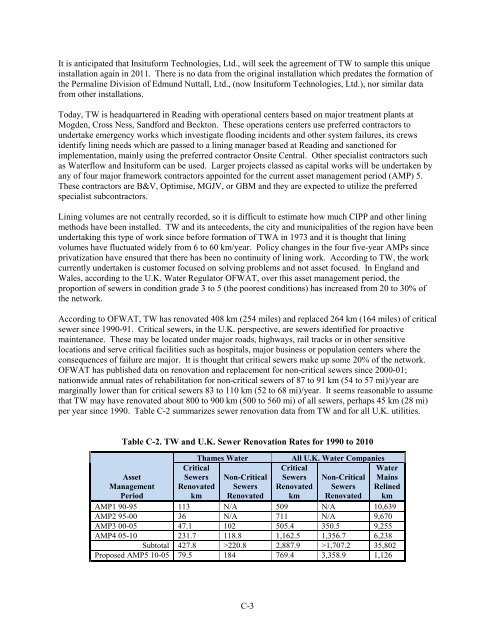Retrospective Evaluation of Cured-in-Place Pipe - (NEPIS)(EPA ...
Retrospective Evaluation of Cured-in-Place Pipe - (NEPIS)(EPA ...
Retrospective Evaluation of Cured-in-Place Pipe - (NEPIS)(EPA ...
You also want an ePaper? Increase the reach of your titles
YUMPU automatically turns print PDFs into web optimized ePapers that Google loves.
It is anticipated that Insituform Technologies, Ltd., will seek the agreement <strong>of</strong> TW to sample this unique<br />
<strong>in</strong>stallation aga<strong>in</strong> <strong>in</strong> 2011. There is no data from the orig<strong>in</strong>al <strong>in</strong>stallation which predates the formation <strong>of</strong><br />
the Permal<strong>in</strong>e Division <strong>of</strong> Edmund Nuttall, Ltd., (now Insituform Technologies, Ltd.), nor similar data<br />
from other <strong>in</strong>stallations.<br />
Today, TW is headquartered <strong>in</strong> Read<strong>in</strong>g with operational centers based on major treatment plants at<br />
Mogden, Cross Ness, Sandford and Beckton. These operations centers use preferred contractors to<br />
undertake emergency works which <strong>in</strong>vestigate flood<strong>in</strong>g <strong>in</strong>cidents and other system failures, its crews<br />
identify l<strong>in</strong><strong>in</strong>g needs which are passed to a l<strong>in</strong><strong>in</strong>g manager based at Read<strong>in</strong>g and sanctioned for<br />
implementation, ma<strong>in</strong>ly us<strong>in</strong>g the preferred contractor Onsite Central. Other specialist contractors such<br />
as Waterflow and Insituform can be used. Larger projects classed as capital works will be undertaken by<br />
any <strong>of</strong> four major framework contractors appo<strong>in</strong>ted for the current asset management period (AMP) 5.<br />
These contractors are B&V, Optimise, MGJV, or GBM and they are expected to utilize the preferred<br />
specialist subcontractors.<br />
L<strong>in</strong><strong>in</strong>g volumes are not centrally recorded, so it is difficult to estimate how much CIPP and other l<strong>in</strong><strong>in</strong>g<br />
methods have been <strong>in</strong>stalled. TW and its antecedents, the city and municipalities <strong>of</strong> the region have been<br />
undertak<strong>in</strong>g this type <strong>of</strong> work s<strong>in</strong>ce before formation <strong>of</strong> TWA <strong>in</strong> 1973 and it is thought that l<strong>in</strong><strong>in</strong>g<br />
volumes have fluctuated widely from 6 to 60 km/year. Policy changes <strong>in</strong> the four five-year AMPs s<strong>in</strong>ce<br />
privatization have ensured that there has been no cont<strong>in</strong>uity <strong>of</strong> l<strong>in</strong><strong>in</strong>g work. Accord<strong>in</strong>g to TW, the work<br />
currently undertaken is customer focused on solv<strong>in</strong>g problems and not asset focused. In England and<br />
Wales, accord<strong>in</strong>g to the U.K. Water Regulator OFWAT, over this asset management period, the<br />
proportion <strong>of</strong> sewers <strong>in</strong> condition grade 3 to 5 (the poorest conditions) has <strong>in</strong>creased from 20 to 30% <strong>of</strong><br />
the network.<br />
Accord<strong>in</strong>g to OFWAT, TW has renovated 408 km (254 miles) and replaced 264 km (164 miles) <strong>of</strong> critical<br />
sewer s<strong>in</strong>ce 1990-91. Critical sewers, <strong>in</strong> the U.K. perspective, are sewers identified for proactive<br />
ma<strong>in</strong>tenance. These may be located under major roads, highways, rail tracks or <strong>in</strong> other sensitive<br />
locations and serve critical facilities such as hospitals, major bus<strong>in</strong>ess or population centers where the<br />
consequences <strong>of</strong> failure are major. It is thought that critical sewers make up some 20% <strong>of</strong> the network.<br />
OFWAT has published data on renovation and replacement for non-critical sewers s<strong>in</strong>ce 2000-01;<br />
nationwide annual rates <strong>of</strong> rehabilitation for non-critical sewers <strong>of</strong> 87 to 91 km (54 to 57 mi)/year are<br />
marg<strong>in</strong>ally lower than for critical sewers 83 to 110 km (52 to 68 mi)/year. It seems reasonable to assume<br />
that TW may have renovated about 800 to 900 km (500 to 560 mi) <strong>of</strong> all sewers, perhaps 45 km (28 mi)<br />
per year s<strong>in</strong>ce 1990. Table C-2 summarizes sewer renovation data from TW and for all U.K. utilities.<br />
Table C-2. TW and U.K. Sewer Renovation Rates for 1990 to 2010<br />
Asset<br />
Management<br />
Period<br />
Critical<br />
Sewers<br />
Renovated<br />
km<br />
Thames Water All U.K. Water Companies<br />
Non-Critical<br />
Sewers<br />
Renovated<br />
C-3<br />
Critical<br />
Sewers<br />
Renovated<br />
km<br />
Non-Critical<br />
Sewers<br />
Renovated<br />
Water<br />
Ma<strong>in</strong>s<br />
Rel<strong>in</strong>ed<br />
km<br />
AMP1 90-95 113 N/A 509 N/A 10,639<br />
AMP2 95-00 36 N/A 711 N/A 9,670<br />
AMP3 00-05 47.1 102 505.4 350.5 9,255<br />
AMP4 05-10 231.7 118.8 1,162.5 1,356.7 6,238<br />
Subtotal 427.8 >220.8 2,887.9 >1,707.2 35,802<br />
Proposed AMP5 10-05 79.5 184 769.4 3,358.9 1,126















